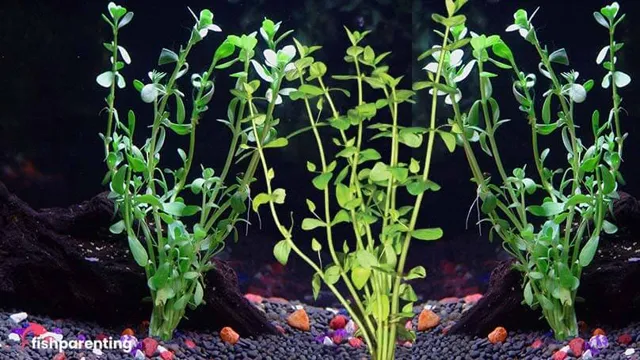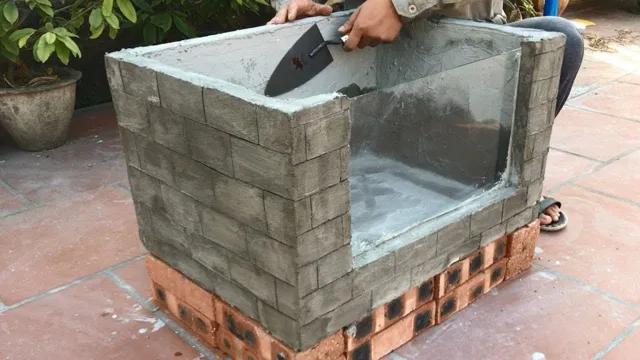How to Clean Moneywort Aquarium Plants: Tips and Tricks for a Healthy Tank

Are you looking for a great addition to your aquarium that not only adds a vibrant pop of color but also helps keep your water clean? Look no further than moneywort! This aquatic plant is a popular choice among aquarium enthusiasts for its easy maintenance and effectiveness in absorbing excess nutrients from the water. However, like any plant, moneywort does require some cleaning and upkeep to ensure it remains healthy and thriving. In this blog post, we’ll walk you through how to clean your moneywort aquarium plants to promote optimal growth and cleanliness in your aquatic environment.
So, grab your gloves and let’s get started!
Introduction
Keeping an aquarium clean is necessary for a thriving aquatic setup, and this includes the plants as well. Moneywort is a popular aquarium plant that can become dirty and unsightly over time. To clean it properly, start by gently removing any debris or algae that may have accumulated on the plant’s leaves.
You can use a soft-bristled toothbrush or a clean, damp cloth to remove the impurities. Also, trim any dead or decaying leaves to promote new growth and prevent the spread of disease. If necessary, you can use a diluted solution of hydrogen peroxide or bleach to kill any harmful microorganisms living on the plants.
Be sure to rinse the plants thoroughly with clean water before placing them back in the aquarium. Keeping your plants clean and maintained will help keep your aquarium environment healthy and visually appealing.
Why Clean Moneywort Plants?
Moneywort plants are not only beautiful, but they also play a crucial role in maintaining the aquatic ecosystem. However, just like any other plant, they require regular maintenance to ensure they stay healthy and vibrant. One of the essential maintenance activities for moneywort plants is cleaning them.
Cleaning the plants involves removing any debris, dead leaves, or algae buildup that may hinder their growth and health. By cleaning your moneywort plants regularly, you not only improve their appearance but also promote their overall health, leading to a thriving aquatic environment. Therefore, it’s important to give your moneywort plants the attention they deserve to keep them looking their best.

Preparation
Cleaning aquarium plants is essential to maintain a healthy environment for your fish to thrive in. Moneywort plants are great for beginners due to their low maintenance, but they still need some TLC every once in a while. Before you start cleaning your moneywort aquarium plants, make sure to prepare everything you need.
This will save you time and make the cleaning process a lot smoother. You will need a clean bucket, a soft-bristled brush, and some aquarium-safe cleaner. Prepare a cleaning solution by mixing the aquarium-safe cleaner with some water in the bucket.
Take the plants out of the tank and rinse them thoroughly under running water to remove any loose debris. Once your plants are out of the tank, use a soft-bristled brush to gently scrub off any algae or debris that has accumulated on the leaves. Be careful not to damage the plants, especially the delicate stems and leaves.
Submerge the plants in the cleaning solution for a few minutes, then rinse them thoroughly under running water again to remove any residual cleaner. Let the plants dry out before placing them back in the aquarium, so the remaining water won’t cause any fluctuations in water parameters. A bonus tip to make cleaning easier is to keep up with regular maintenance, like removing dead leaves and detritus, from the aquarium so there’s less build-up to clean.
By following these preparation tips, your moneywort aquarium plants will not only look better, but your fish will be healthier and happier too!
Remove Plant From Aquarium
Removing plants from an aquarium can be a delicate process that requires some preparation. Before beginning, make sure you have the necessary tools, including a pair of scissors, tweezers, and a clean container. It’s important to carefully analyze the plant you want to remove and consider any potential damage to your aquarium’s ecosystem.
If the plant is healthy, carefully cut the stem near the base with the scissors. Use the tweezers to gently pull out the roots while taking care not to disturb the surrounding substrate. If the plant is dead or dying, it’s crucial to remove it immediately to prevent any rotting or ammonia buildup.
Once the plant is removed, be sure to clean the container thoroughly before disposing of the plant. By taking these precautions, you can successfully remove a plant from your aquarium without causing any harm to your aquatic pets or plants. (See Also: How to Buff Scratches Out of Aquarium Glass: A Step-by-Step Guide)
Inspect The Plant
Inspecting the plant before starting any gardening work is essential to ensure its health and productivity. Preparation beforehand can make the process easier and more effective in yield. The first step is assessing the overall health of the plant.
Check for any signs of disease, pests, or damage. Look for discolored spots, holes, or mold. If you observe any symptoms, act quickly by removing any diseased leaves or trimming damaged parts.
Secondly, inspect the soil for moisture and nutrients. The soil should be moist but not excessively damp, and it should have the required nutrients for the plant. A thorough inspection of the plant will provide you with a better understanding of its needs.
In this way, you can determine the best course of action to take to guarantee healthy growth and a plentiful harvest.
Fill a Bowl with Water
If you’re planning to fill a bowl with water, there are a few things you’ll need to consider before getting started. First, you’ll want to select a bowl that is large enough to hold the amount of water you need. You don’t want to overcrowd the bowl or risk spilling water everywhere.
Make sure you choose a sturdy bowl that won’t tip over easily, especially if you’re filling it to the brim. Once you have your bowl ready, fill your kettle or pot with the amount of water you need and bring it to a boil. If you’re not using a kettle or pot, you can simply turn on your faucet and let the water run until it reaches the desired level.
Be careful not to let the water overflow, as this can be dangerous and cause damage to your flooring or furniture. Once you’ve filled the bowl with water, you can add any decorations or items you’d like to create a beautiful centerpiece for your home. By following these simple steps, you can easily fill a bowl with water and create a stunning display for any occasion.
Cleaning Process
If you have a moneywort aquarium plant, you’ll need to keep it clean for the health and well-being of your fish. To start, remove any dead leaves or debris from the plant and surrounding area. Next, fill a container with water and add a mild aquarium-safe cleaner.
Soak the plant in the mixture for a few minutes and then gently scrub it with a soft brush to remove any dirt or algae. Rinse the plant thoroughly with fresh water and then place it back into the aquarium. Remember not to use any harsh chemicals or cleaners that could harm your fish or other aquatic plants.
By following these simple steps, you’ll have a clean and healthy moneywort aquarium plant in no time!
Soak the Plant
One important step in the plant cleaning process is soaking the plant. Soaking can help to remove any stubborn dirt or debris that may be stuck to the leaves or in the soil. To soak the plant, choose a container that is large enough to accommodate the size of your plant.
Fill the container with water until the plant is submerged, and let it soak for about 30 minutes to an hour. Be sure to use room temperature or lukewarm water, as hot or cold water can shock the plant. After soaking, gently agitate the water to dislodge any dirt, and then carefully remove the plant and allow it to drain thoroughly before returning it to its pot.
Soaking can be a great way to keep your plants clean and healthy, but be sure to only do it as often as necessary, as too much soaking can lead to over-watering and damage to the roots. (See Also: How to Make a Cheap Aquarium Sump: Detailed DIY Guide for Affordable Filtration Setup)
Use a Soft Brush to Gently Clean
When it comes to cleaning your cherished possessions, such as delicate porcelain figurines or antique heirlooms, it’s crucial to be gentle and precise in your approach. Using a soft brush to gently remove any debris or dust can be an effective way to keep your items looking their best without causing any damage. It’s important to choose a brush that won’t scratch or scrape the surface of your item.
You may even want to use a specialized brush specifically designed for delicate items to ensure the best results. By taking the time to carefully clean your belongings using a gentle touch, you can help to maintain their beauty and value for years to come. So, next time you’re faced with the task of cleaning your precious possessions, remember to opt for a soft brush and handle with care.
Rinse the Plant Thoroughly
When it comes to caring for your plants, one crucial step is to rinse them thoroughly. This cleaning process is essential to remove any dust, debris, or insects that may have accumulated on the leaves or stem. By doing so, the plant will be able to absorb nutrients and sunlight more efficiently, resulting in a healthier and more vibrant appearance.
To rinse your plant, simply place it under a gentle stream of lukewarm water, making sure to cover all parts of the plant. You can also wipe the leaves and stem with a damp cloth or sponge to remove any stubborn dirt. Remember to be gentle when handling the foliage, as excessive rubbing or pressure can cause damage.
By incorporating this simple step into your plant care routine, you can ensure that your green friends flourish and thrive.
Maintenance Tips
If you have Moneywort aquarium plants, it’s essential to know how to clean them properly. These plants are well-known for their lush, green beauty, but without the right maintenance, they can become unattractive and even harmful to your aquatic pets. To clean Moneywort aquarium plants, start by ensuring that your aquarium water is fresh and clean.
Any debris or dirt in the water can soil the leaves of the plant. Use a soft-bristled brush to gently brush away any dirt on the leaves. Be careful not to pull or tug at the plants, as this can damage the roots.
Additionally, it’s recommended to periodically remove any dead or yellow leaves to promote healthy growth. To maximize the lifespan of your Moneywort aquarium plants, keep them in water that is not too acidic or too alkaline. If you notice any signs of decay or discoloration, remove the affected areas immediately to prevent the spread of disease.
With these simple cleaning tips, your Moneywort aquarium plants will thrive, providing both aesthetic appeal and a healthy environment for your aquatic pets.
Routine Cleaning Schedule
A routine cleaning schedule is a must for maintaining a clean and healthy living space. However, it’s not just about wiping down surfaces and scrubbing floors. It’s also important to regularly clean appliances, air filters, and even light fixtures.
By establishing a routine cleaning schedule, you can ensure that all areas of your home are properly maintained and prevent the buildup of dirt and bacteria. Start by creating a checklist of all the areas and items that need to be cleaned on a regular basis. Then, establish a frequency for each task and create a cleaning schedule that suits your needs.
Remember to also consider any specific cleaning products or tools that may be needed for certain tasks. With a routine cleaning schedule in place, you can not only maintain a clean and healthy living space but also save time and stress in the long run.
Avoiding Contaminants
When it comes to avoiding contaminants, regular maintenance is key. Firstly, it’s important to change air filters regularly to prevent dust and other pollutants from circulating throughout your home. This can also improve the efficiency of your HVAC system, saving you money on energy bills.
Additionally, keeping your home clean and decluttered can help reduce the likelihood of mold and mildew growth, which can exacerbate allergies and respiratory issues. Be sure to inspect your plumbing and fix any leaks promptly, as standing water can attract pests and bacteria. Lastly, if you have pets or use harsh chemicals for cleaning, be sure to ventilate your home to prevent indoor air pollution. (See Also: How Often Should You Change an Aquarium Filter? A Comprehensive Guide)
By following these maintenance tips, you can improve the quality of the air in your home and reduce the risk of contaminants.
Conclusion
In conclusion, cleaning your moneywart aquarium plants may seem like a daunting task, but with a few simple steps, you can make your aquatic environment sparkle like new money. Don’t be afraid to get your hands dirty and take the time to properly scrub each leaf. By keeping your plants healthy and clean, your fish will thank you with a fin-tastic display of vibrant colors and lively energy.
So, whether you’re a seasoned aquarist or just starting out, remember that a little elbow grease goes a long way when it comes to maintaining a beautiful and thriving underwater world. Happy cleaning!”
FAQs
Why do moneywort aquarium plants need to be cleaned?
Moneywort aquarium plants need to be cleaned to prevent the buildup of algae and to maintain water quality for fish.
Can I use soap or other cleaning products on my moneywort plants?
No, using soap or other cleaning products can harm the plants and fish. Rinsing with water is the best way to clean the plants.
How often should I clean my moneywort plants?
It is recommended to clean the plants every 2-4 weeks, depending on the amount of algae buildup.
Can I remove the moneywort plants from the aquarium to clean them?
Yes, if the plants are heavily covered in algae, you may choose to remove them from the aquarium and gently clean them with water.
Is it necessary to trim or prune the moneywort plants while cleaning?
Yes, it is recommended to trim or prune any dead or dying leaves while cleaning to promote healthy growth.
Can I add any cleaning products to the aquarium water to help clean the moneywort plants?
No, using any cleaning products can harm the plants or fish. Regular water changes and proper filtration are the best ways to maintain water quality.
Are there any specific tools or equipment needed to clean moneywort plants?
No, only a gentle rinse or light scrubbing with water is needed to clean the plants. However, aquarium-safe gloves may be helpful to avoid any irritation or allergies.






